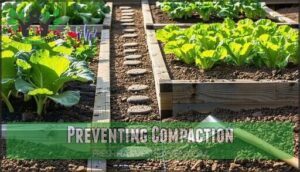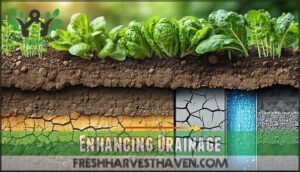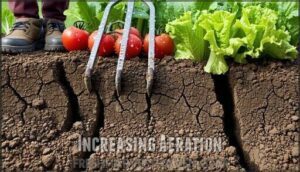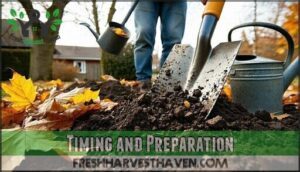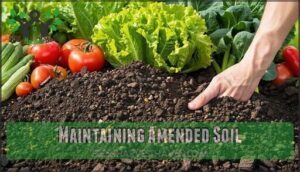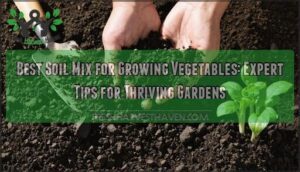This site is supported by our readers. We may earn a commission, at no cost to you, if you purchase through links.
 You’ll transform stubborn clay soil into a vegetable garden paradise by working in 2-4 inches of compost annually, which breaks up those concrete-like clumps and creates breathing room for roots.
You’ll transform stubborn clay soil into a vegetable garden paradise by working in 2-4 inches of compost annually, which breaks up those concrete-like clumps and creates breathing room for roots.
Mix in coarse organic matter like aged bark or perlite to improve drainage, since waterlogged clay suffocates plants faster than you can say "root rot."
Apply gypsum powder to naturally separate clay particles without messing with pH levels, but skip the sand—it’ll turn your garden into a brick patio.
Work amendments into the top 8-12 inches during fall when soil isn’t muddy, as timing and technique make all the difference when transforming clay, and master gardeners know this.
Table Of Contents
- Key Takeaways
- Amending Clay Soil Basics
- How to Amend Clay Soil
- Choosing Right Amendments
- Improving Soil Structure
- Timing and Preparation
- Maintaining Amended Soil
- Frequently Asked Questions (FAQs)
- What is the best way to amend clay soil?
- What is a good soil amendment for clay soil?
- How do you improve clay soil?
- Can you add organic matter to clay soil?
- Can clay soil be used as garden soil?
- Should you plant cover crops on clay soil?
- How can i Improve my clay soil?
- How to grow vegetables in clay soil?
- Can you add compost to clay soil?
- How to make clay soil better for vegetable garden?
- Conclusion
Key Takeaways
- You’ll transform stubborn clay soil by working in 2-4 inches of compost annually, which breaks up dense particles and creates the breathing room your vegetable roots need to thrive.
- Mix coarse organic matter like aged bark or perlite to improve drainage, since waterlogged clay kills plants faster than poor nutrition—but never add sand, as it’ll turn your garden into concrete.
- Apply gypsum powder at 20 pounds per 1,000 square feet to naturally separate clay particles without changing pH levels, giving you better soil structure without the guesswork.
- Time your amendments for fall when soil isn’t muddy, working materials into the top 8-12 inches—this timing lets winter weather naturally break down organic matter before spring planting season.
Amending Clay Soil Basics
Clay soil’s dense particles create drainage problems and compaction issues, but you can transform this challenging medium into productive garden soil with the right amendments.
Understanding clay’s characteristics, including its excellent nutrient retention and poor aeration, helps you choose effective improvement strategies that work with the soil’s natural properties, using its dense particles to your advantage.
Clay Soil Characteristics
Clay soil’s makeup tells its own story through microscopic particles smaller than 0.002 mm that pack together like puzzle pieces.
Clay’s microscopic puzzle pieces create both challenges and opportunities for the determined gardener.
This dense soil texture creates a double-edged sword for gardeners—excellent water retention and nutrient density, but stubborn drainage and compaction issues that’ll test your patience.
Understanding heavy clay soil means recognizing these key traits:
- Slow warming properties that delay spring planting
- Alkaline pH levels affecting plant nutrient uptake
- Dense particle structure causing soil compaction under pressure.
While clay’s nutrient-holding power surpasses sandy soils, its tight structure demands strategic amendments for successful vegetable gardening.
Adding organic matter can substantially improve clay soil.
Challenges of Clay Soil
Working with heavy clay soil feels like wrestling with concrete.
Transforming stubborn clay into garden gold requires patience, but the payoff is worth every shovelful of compost.
You’ll encounter these major obstacles that make vegetable gardening frustrating:
- Poor soil drainage: Water retention creates waterlogged conditions that suffocate roots
- Severe soil compaction: Dense particles prevent healthy root growth and expansion
- Delayed spring warm-up: Cold clay slows germination and planting schedules
- High alkaline pH: Nutrient availability becomes limited for most vegetables
Amending clay soil requires patience and proper techniques.
How to Amend Clay Soil
Several proven methods transform stubborn clay into garden gold. The secret lies in strategic clay soil amendment techniques that address compaction and drainage issues simultaneously.
Here’s your step-by-step approach for amending clay soil:
- Mix organic matter: Incorporate 3-6 inches of compost into the top 10 inches using amendment tools like spades or broadforks.
- Apply gypsum: Spread 20 pounds per 1,000 square feet to break clay clumps without changing pH.
- Plant cover crops: Use daikon radishes or clover for natural soil improvement through root penetration.
- Aerate regularly: Create air pockets with digging forks, then add amendments for long-term maintenance success.
To improve aeration, consider how soil structure impacts root development.
Choosing Right Amendments
When you’re ready to transform your stubborn clay soil, selecting the right amendments makes the difference between success and frustration.
You’ll want to focus on proven organic materials like compost and well-rotted manure, while avoiding common mistakes such as adding sand that can create a concrete-like mess.
Organic Matter Incorporation
Your clay soil amendment success hinges on organic matter incorporation.
Think of it as feeding your soil’s appetite for improvement.
Compost layering works best—spread 3-6 inches and work it into the top 10-12 inches of soil.
Manure benefits include enhanced drainage, while leaf mold breaks up dense particles naturally.
Worm castings act like soil vitamins, boosting nutrient availability.
Green manures like clover add nitrogen while improving structure.
This organic soil amendment approach transforms stubborn clay into fertile ground that vegetables actually want to grow in.
Benefits of Compost
Transformation happens when you add compost to your clay soil amendment project.
This powerhouse organic material works three ways:
- Nutrient cycling accelerates as microorganisms break down organic matter
- Soil structure improves through aggregation of clay particles
- Water retention balances with better drainage capabilities
Your vegetable garden soil benefits from this microorganism boost, making amending clay soil incredibly effective for soil improvement.
Adding compost also introduces beneficial mycorrhizal fungi enhance nutrient uptake.
Using Gypsum Powder
The calcium sulfate mineral works differently than compost for clay soil amendment.
Gypsum for clay soil breaks down sodium-rich particles without changing pH levels, making amending clay soil more predictable.
Apply 20 pounds per 1,000 square feet, mixing into the top 10-12 inches.
Gypsum benefits include improved drainage and reduced compaction, though gypsum alternatives like compost provide additional nutrients that gypsum lacks.
Gypsum is especially effective at improving sodic and dispersive soil.
Avoiding Sand Additions
Adding sand to clay soil creates more problems than solutions.
When you mix sand with clay particles, you’re basically making a cement-like mixture that hardens like concrete.
The particle size differences between fine clay and coarse sand don’t complement each other—they create an impermeable barrier.
Here’s why amending clay soil with sand backfires:
- Cement-like mixture forms when clay binds to sand grains
- Drainage complications worsen as water can’t penetrate the hardened layer
- Compaction risk increases, making root growth nearly impossible
- Long-term damage occurs to your soil structure permanently
Instead of sand for amending garden soil, focus on organic matter like compost.
Adding sand can actually lead to increased soil compaction.
Heavy clay soil responds better to materials that improve structure naturally, not inert particles that create concrete in your beds.
Improving Soil Structure
You’ll transform your dense, compacted clay into workable garden soil by focusing on four key structural improvements that address drainage, aeration, and root penetration.
These targeted techniques break up clay’s tight particle structure, creating the loose, well-draining environment your vegetables need to thrive, which involves improving the soil’s overall aeration.
Adding Organic Matter
Organic matter acts like a sponge in your vegetable garden soil, transforming dense clay into workable earth.
Compost benefits include improved drainage and nutrient cycling, while manure options provide slow-release fertility. Leaf mold creates perfect soil structure, and worm castings add beneficial microorganisms.
| Amendment Type | Application Rate |
|---|---|
| Compost | 3-4 inches per season |
| Well-rotted manure | 2-3 inches annually |
| Leaf mold | 2-4 inches mixed in |
| Worm castings | 1-2 inches top-dressed |
| Cover crop residue | Till in before decomposition |
Clay soil amendment requires patience, but these materials gradually improve soil pH balance and create the loose, fertile foundation your vegetables crave.
To further enhance soil health, consider how mycorrhizal fungi enhance nutrient absorption.
Preventing Compaction
Heavy clay soil compacts easily, but you can protect your garden with smart practices.
Here’s how to prevent soil compaction:
- Minimize foot traffic by installing stepping stones or permanent garden paths
- Apply mulch regularly to cushion soil surface from rain impact
- Use aeration techniques like broadforking instead of excessive tilling
- Plant cover crops during off-seasons to naturally break up dense layers
- Build raised beds to maintain loose soil structure year-round
Enhancing Drainage
Looking to transform waterlogged clay into a thriving vegetable garden? Gypsum application breaks down dense particles, while raised beds provide immediate drainage solutions.
French drains redirect excess water effectively. Many gardeners find gypsum soil amendments helpful for this purpose.
Contour building channels water naturally, preventing pooling that kills vegetable roots.
| Method | Timeline | Effectiveness |
|---|---|---|
| Gypsum Application | 3-6 months | 40-60% improvement |
| Raised Beds | Immediate | 25-35% reduction |
| French Drains | 1-2 weeks | 50-75% water redirect |
Increasing Aeration
Proper soil aeration transforms your compacted clay into a thriving garden foundation. Seasonal Aeration works best in fall and spring when moisture levels allow effective Countering Compaction. Aeration Timing matters—never work waterlogged soil.
- Broadfork Technique penetrates deep without destroying soil structure
- Digging Forks break up surface compaction around existing plants
- Core aerators create channels for improved drainage and root growth
- Double digging reaches deeper clay layers for thorough soil structure improvement
- Regular soil aeration prevents future compaction while amending clay soil
Timing and Preparation
You’ll achieve the best results when you time your clay soil amendments correctly, as seasonal conditions directly affect how well organic matter integrates with dense clay particles.
Fall provides the ideal window for major soil improvements, since winter weather naturally breaks down compost and organic materials.
While early spring offers your last chance to prepare beds before planting season begins, it is essential to consider the timing to ensure the best integration of organic matter with the dense clay particles.
Fall Amendments
Fall amendments transform your clay soil while you’re sipping hot cocoa indoors.
Spread 2-3 inches of compost across your vegetable garden beds, allowing winter decomposition to work its magic.
Add gypsum benefits by sprinkling this soil amendment over compacted areas.
Conduct soil testing now to identify pH and nutrient needs before spring planting.
This compost application timing gives organic matter months to break down, creating the perfect foundation for amending clay soil successfully.
Early Spring Preparation
Early spring marks the perfect window for clay soil transformation.
Conduct your Spring Soil Test when temperatures hit 50°F consistently.
Begin Early Amendments by mixing compost into slightly moist soil—never waterlogged clay.
Tool Readiness means having your broadfork and amendments prepared.
This Planting Timeline sets your vegetable garden preparation up for success.
Warming Strategies like mulching accelerate the process naturally.
New Garden Beds
When establishing new garden beds in clay soil, start with thorough bed preparation through soil testing to determine amendment needs.
Your vegetable garden’s success depends on proper soil amendment from day one.
- Test soil pH and nutrient levels before breaking ground
- Layer 6-8 inches of compost directly onto clay surface
- Mix amendments into top 12 inches using broadfork instead of tiller
- Plan raised beds for improved drainage and initial planting success
Maintaining Amended Soil
Once you’ve successfully amended your clay soil, maintaining these improvements requires ongoing attention to prevent your hard work from reversing.
You’ll need to monitor soil health regularly, apply organic mulch annually, and avoid practices that cause compaction to keep your vegetable garden thriving year after year, which involves paying attention to the details of organic mulch.
Monitoring Soil Health
Track your amended clay soil’s progress like a detective gathering clues.
Regular soil testing reveals nutrient availability, soil pH, and organic matter levels that determine plant success.
Watch for earthworms during digging—they’re nature’s soil health indicators, showing active microbial activity.
| Health Indicator | What to Look For |
|---|---|
| Nutrient Levels | Balanced N-P-K ratios |
| Water Retention | Moist but not waterlogged |
| Compaction Testing | Easy root penetration |
Visual inspections reveal compaction testing results through improved drainage patterns.
Mulching and Cover Cropping
Two proven methods keep your amended clay soil healthy year-round: mulch and cover crop strategies.
Mulch benefits include preventing surface crusting while organic materials like wood chips gradually break down into valuable soil amendment. Effective gardening often requires specific mulch products for clay.
- No-till mulching maintains soil structure while suppressing weeds
- Deep-rooted cover crop varieties break up compacted clay layers naturally
- Diverse plantings enhance your vegetable garden‘s microbial health substantially
Cover crop types such as clover and daikon radish create natural green manure when tilled under. Winter cover crops protect soil structure during dormant months.
Avoiding Overwatering
Clay soil holds water like a sponge, making overwatering your garden’s biggest enemy. Poor drainage solutions lead to waterlogged roots and plant death. Smart watering frequency prevents root rot while meeting plant needs.
Follow these drainage improvement steps:
- Test soil moisture – Insert finger two inches deep before watering
- Water deeply weekly – Skip daily sprinkles that worsen clay soil problems
- Monitor drainage – Watch for pooling water after rain or irrigation
Annual Aeration and Maintenance
Beyond regular watering practices, soil aeration becomes your yearly maintenance ritual.
Use broadforks or core aerators twice annually—fall and spring—for ideal Aeration Frequency. Smart Tool Selection prevents compaction while Amendment Timing with post-aeration compost maximizes soil structure improvement.
Plant cover crops for natural soil improvement and Long-Term Benefits. Skip excessive tilling to protect your organic matter investment and successfully amend clay soil.
Frequently Asked Questions (FAQs)
What is the best way to amend clay soil?
Add generous amounts of compost, aged manure, or leaf mold to break up dense particles.
You’ll improve drainage and create looser soil structure.
Work amendments into the top 8-12 inches for best results.
What is a good soil amendment for clay soil?
Think your clay’s stubborn as a mule? You’ll want compost as your go-to amendment—it’s the soil whisperer that breaks up dense particles while feeding nutrients.
Well-rotted manure works magic too, improving drainage naturally.
How do you improve clay soil?
You’ll transform stubborn clay by mixing in 3-6 inches of compost annually, aerating with a broadfork, and avoiding wet-soil work.
Gypsum helps too, but organic matter’s your secret weapon for drainage.
Can you add organic matter to clay soil?
Heavy clay fights against drainage, but organic matter transforms this stubborn soil into garden gold.
You’ll improve structure by mixing compost, aged manure, or leaf mold directly into your clay beds for better vegetable growing success.
Can clay soil be used as garden soil?
Yes, you can use clay soil for gardening, but it needs amendments first.
Clay’s dense structure retains nutrients well but drains poorly.
Add compost and organic matter to improve drainage and create better growing conditions, which can make clay soil more suitable for gardening with the right amendments.
Should you plant cover crops on clay soil?
Cover crops are clay soil’s best friend, breaking up compacted earth like natural tillers.
You’ll want to plant legumes like clover or crimson clover in fall – they’ll add nitrogen and organic matter while improving drainage naturally, with clover being a key option.
How can i Improve my clay soil?
You’ll break up compacted clay by adding 3-6 inches of compost and working it into the top 10-12 inches.
Mix in aged manure or leaf mold, then avoid walking on beds to prevent re-compaction.
How to grow vegetables in clay soil?
Like coaxing a stubborn mule to cooperate, you’ll need patience with clay soil.
Choose clay-tolerant vegetables like broccoli, cabbage, and beans.
Improve drainage through raised beds and organic matter while selecting varieties that thrive in dense conditions.
Can you add compost to clay soil?
Adding compost to clay soil works brilliantly! You’ll improve drainage, break up compaction, and boost nutrients. Mix 2-3 inches into the top 6-12 inches of soil for best results.
How to make clay soil better for vegetable garden?
Mix 3-6 inches of compost into your clay soil during fall or early spring.
You’ll improve drainage, loosen compacted particles, and create better growing conditions for vegetables while adding essential nutrients.
Conclusion
While transforming clay soil might seem overwhelming, you’ve now learned how to amend clay soil for vegetable garden success through proven techniques.
Start with 2-4 inches of compost, add gypsum for particle separation, and incorporate coarse organic matter for drainage.
Work amendments into the top 8-12 inches during fall when conditions are right, with consistent annual additions and proper timing, you’ll create the loose, fertile soil that vegetables crave.
Your patience will reward you with thriving garden beds.
- https://books.tenthacrefarm.com/the-permaculture-inspired-vegetable-garden/?utm_source=taf&utm_campaign=TPIVG2&utm_medium=banner1-link
- https://learningandyearning.com/fall-leaves-a-valuable-soil-builder
- https://pickyourown.org/countyextensionagentoffices.htm
- https://gardentabs.com/should-add-sand-to-clay-soil/
- https://extension.oregonstate.edu/news/clay-soil-challenges-solutions-oregon-gardeners



